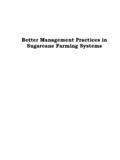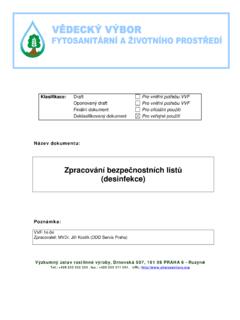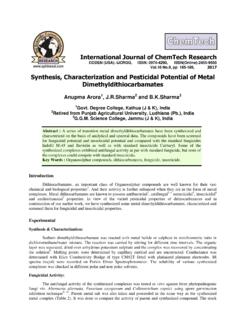Transcription of SYSTEM OF RICE INTENSIFICATION (SRI) - …
1 Directorate of rice Development, Patna 1 SYSTEM OF rice INTENSIFICATION (SRI) - principles AND methods 1. principles SRI is based on the following principles : Young seedlings between 8-12 days old (2-3 leaf stage) are transplanted to preserve potential for tillering and rooting ability; Careful planting of single seedlings rather than in clumps that are often plunged in the soil; Wider spacing at 25 cm x 25 cm. in square planting rather than in rows; Use of cono-weeder/ rotary hoe/power weeder to aerate the soil as well as controlling weeds; Alternate wetting and dry method rather than continuous flooding in the field; Use of organic manure or vermicompost / FYM. 2. methods The SYSTEM of rice INTENSIFICATION is not a new method or technology. It is just altering the management practices to make more productive phenotype from the same genotype of rice plant.
2 Artificial environment is created for growth and development of rice plant for exploitation of its full genetic potential, land and water resources. It can be accomplished by the following methods : Raising nursery (a) Selection of site In SRI method, utmost care should be taken in the preparation of nursery bed, as 8-12 days old seedlings and in some places 14-15 days old seedlings (2-3 leaf stage) are transplanted. The nursery bed should be preferably prepared in the centre / corner of the plot for quick / efficient transplanting. Directorate of rice Development, Patna 2 (b) Size of bed For one acre transplantation, the nursery bed can be raised in 48 square yard (40 sq meter) plot. Depending upon the situation, two beds can be raised each measuring 24 sq. yards (20 sq meters) per 1 kg seed. A bed with a width of 125 cm or 4 feet is ideal. Length of the bed can be decided by the farmers depending on the ground situation.
3 Accordingly to one s convenience either a single bed or several small beds (4 beds measuring 4 X 28 feet or X 8 m each, Fig-1) can be prepared. As the roots of 8-10 days old seedlings grow up to 3 inches ( cm), it is necessary to prepare raised beds of 5-6 inches ( cm). To drain excess water, appropriate channels should be provided on all sides by making drainage cum irrigation channels ( feet width). To prevent soil erosion, the bed on all side should be made secure with wooden reapers / planks or paddy straw, etc. 8m 8m 8m 8m 8m 8m 8m 8m 1 ft 1ft 1 ft m m m m Fig: 1 Lay out of Nursery Beds for 1 acre of land ( c ) Bed preparation Nursery bed is prepared with application of farm yard manures (FYM) and soil in four alternating layers.
4 1st layer: 1 inch ( cm) thick well decomposed FYM, 2nd layer: 1 .5 inch ( cm) soil, 3rd layer :1 inch ( cm) thick well decomposed FYM, 4th layer: inch ( cm) soil. All these layers should be mixed well as it will helps in easy penetration of roots. Besides compost or vermi compost can also be used and spread it over all the bed in 3-5 cm layer. Directorate of rice Development, Patna 3 (d) Seed rate 2 kg of seeds (5 kg / ha) is required to transplant in one acre of land. Seed should be thinly spread to avoid crowding of seedlings. Care should be taken that no two seeds should touch each other. (e) Seed Treatment Healthy and pure seeds are used. Soak the seeds for 12 hours in water. Drain the water and treat the seed with bavistin (2 gm / kg seed) or Trychoderma (3 gm / kg seed) or streptocyclin (1gm / kg of seeds).
5 There after transfer the treated seeds to a water soaked gunny bag. Leave it for 24 hours. Sprouted seeds are taken to the nursery for sowing. To ensure uniform broadcasting, divide the seed into four part and broadcast thinly over the bed (each part at a time). It is better to broadcast seeds in the evening. (f) Mulching Cover the bed with paddy straw, to cover from direct exposure to the sun and also to ensure protection from birds. Depending upon requirement, apply water with rose cans twice daily. Care should be taken to see that the seeds do not come out while watering. Remove the straw once seeds germinate. Preparation of main field Land selected for SRI should be well leveled and should not have waterlogging condition. When the plot is irrigated the water should spread uniformly across the field. Similarly, whenever needed there should be provision to drain the excess rain water.
6 Farmers must have their own irrigation resources so that they can provide irrigation whenever it is needed. The main field is prepared and leveled with little standing water a day before planting for grid marking. Provision should be made for 30 cm wide channels at 2 meters interval. Perfect leveling is the pre-requisite for proper water management and good crop stand. Directorate of rice Development, Patna 4 Method of Transplanting The field should be well puddled and leveled. After leveling the field, a marker can be used to lay out the plot into wider spacing , 25 cm x 25 cm row to row and plant to plant. This can also be done with the help of rope by marking. Young rice seedlings 8 to 12 days old and in some places 14-15 days old seedlings (2-3 leaf stage) is considered to be ideal for transplanting as compared to 25-30 days old seedlings in traditional method of rice cultivation.
7 The seedlings with 2-3 leaves stage have great potential for profuse tillering and root development. It results to achieve maximum yield potential of varieties / hybrids. Care should be taken to prevent any harm to seedlings while pulling them from nursery or at the time of transplanting. A metal sheet is inserted 4-5 inches below the seedbed and seedlings scooped along with soil without any disturbance to their roots. Transplanting of tender seedlings need care to minimize root trauma. The farmers and farm labourers need to be educated on this aspect. Young seedlings are planted shallow horizontally thus establish quickly. Seedlings are transplanted with the help of index finger and thumb and by gently placing them at the intersection of marking. Light irrigation should be given on the next day of the transplanting. Nutrient Management Organic manures / vermi compost are recommended in SRI cultivation as they give better response and improve soil health.
8 Application of FYM / compost (10-12 t/ha) before ploughing and incorporation of in situ grown 45-60 days old green manures crops are beneficial. Though complete organic manuring is recommended for SRI, in case of short supply of organics, fertilizer supplementation may be adopted for better yields. Apply and incorporate 50 % of recommended fertilizers (NPK) through in-organics , 50: 30: 20 kg NPK in kharif and 60 : 30 : 20 kg NPK in rabi depending on soil test values at the time of preparation of the field. Directorate of rice Development, Patna 5 Apply second dose (25 per cent ) of N at the time of 2nd weeding (20 DAT) and final dose of 25 per cent N and remaining 25 per cent K a week before panicle initiation stage. Need based N can be applied with the use of Leaf Colour Chart to enhance the N use efficiency Water management SRI method does not require continuous flooding.
9 Irrigation is given to maintain soil moisture near saturation initially and water is let in when surface soil develops hairline cracks. The irrigation intervals, however, vary with soil texture. Soils having low water holding capacity require frequent irrigation. As the soil is not flooded, the roots of the paddy plants grow healthy, deeply in all directions. The root growth is extensive also due to the wide spacing. As the field is intermittently irrigated and dried, the micro organisms grow well which make nutrients available to the plants. This method also helps in better growth and spread of roots. The field should be irrigated again when the soil develops hair line cracks. Depending upon the soil and the environment conditions, the frequency of irrigation should be decided. At the time of weeding operation to avoid shoulder pain, the field should be irrigated to have 2-3 cm of water. After completion of weeding the water should not be let out of the field.
10 After the panicle initiation stage until maturity, one inch of water should be maintained in the field until maturity. The water can be drained after 70 per cent of the grains in the panicle get hardened. Weed Management As there is no standing water in SRI method, weeds would be more. There are several advantages of turning the weeds into the soil by using an implement called weeder . Use the weeder on the 10th and 20th day after transplanting. The weeding problem is addressed to a large extent with this effort. Alternate wetting and drying in SRI results in excessive weed growth which if unchecked in time may cause immense loss in yield. In SRI, the weeds are incorporated by operating cono weeder between rows at the right time, which also supply nutrients to the crop as green manures. First weeding is to be done 10-12 days after planting.




